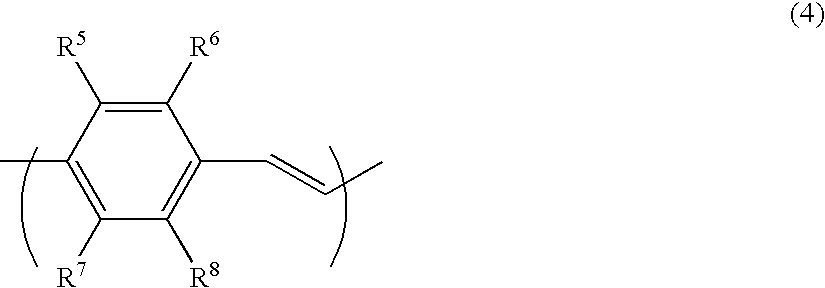Carbon Nanotube Composition, Composite Having a Coated Film Composed of the Same, and Their Production Methods
a technology of carbon nanotubes and composites, which is applied in the direction of non-conductive materials, capacitor electrolytes/absorbents, conductive materials, etc., can solve the problems of damage to the graphene sheet structure of carbon nanotubes, affecting the characteristics of carbon nanotubes, and affecting the quality of carbon nanotubes, etc., to achieve superior electrical conductivity, not impairing the characteristics, and easy to cover or cover
- Summary
- Abstract
- Description
- Claims
- Application Information
AI Technical Summary
Benefits of technology
Problems solved by technology
Method used
Image
Examples
production example 1
Conducting Polymer (A-1)
[0121]Synthesis of Poly(2-sulfo-5-methoxy-1,4-iminophenylene)
[0122]100 mmol of 2-aminoanisol-4-benzene sulfonic acid were stirred and dissolved in a 4 mol / liter aqueous solution of triethylamine at 25° C., then a 100 mmol aqueous solution of ammonium peroxodisulfate was dropped in the mixture. Following completion of dropping and stirring for an additional 12 hours at 25° C., the reaction product was filtered, washed and then dried to obtain 15 g of a polymer powder. The volumetric resistance of this conducting polymer (A-1) was 9.0 Ω·cm.
production example 2
Conducting Polymer (A-2)
[0123]Synthesis of Poly(2-sulfo-1,4-iminophenylene)
[0124]100 mmol of m-aminobenzene sulfonic acid were stirred and dissolved in a 4 mol / liter aqueous solution of trimethylamine at 25° C., then a 100 mmol aqueous solution of ammonium peroxodisulfate was dropped in the mixture. Following completion of dropping and stirring for an additional 12 hours at 25° C., the reaction product was filtered, washed and then dried to obtain 10 g of a polymer powder. The volumetric resistance of this conducting polymer (A-2) was 12.0 Ω·cm.
production example 3
Conducting Polymer (A-3)
Synthesis of Sulfonated Polyaniline
[0125]Poly(2-sulfo-1,4-iminophenylene) was synthesized according to a known method (J. Am. Chem. Soc., (1991), 113, 2665-2666). The sulfonic acid content of the resulting polymer was 52% relative to the aromatic ring. In addition, the volumetric resistance of this conducting polymer (A-3) was 50 Ω·cm.
PUM
| Property | Measurement | Unit |
|---|---|---|
| temperature | aaaaa | aaaaa |
| molar ratio | aaaaa | aaaaa |
| molecular weight | aaaaa | aaaaa |
Abstract
Description
Claims
Application Information
 Login to View More
Login to View More - R&D
- Intellectual Property
- Life Sciences
- Materials
- Tech Scout
- Unparalleled Data Quality
- Higher Quality Content
- 60% Fewer Hallucinations
Browse by: Latest US Patents, China's latest patents, Technical Efficacy Thesaurus, Application Domain, Technology Topic, Popular Technical Reports.
© 2025 PatSnap. All rights reserved.Legal|Privacy policy|Modern Slavery Act Transparency Statement|Sitemap|About US| Contact US: help@patsnap.com



